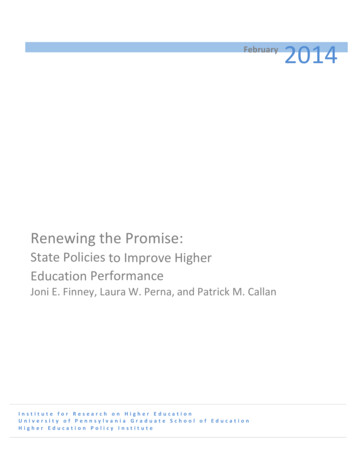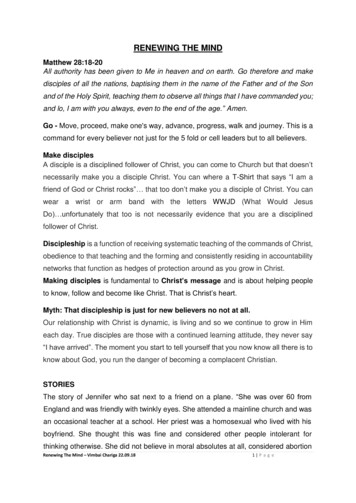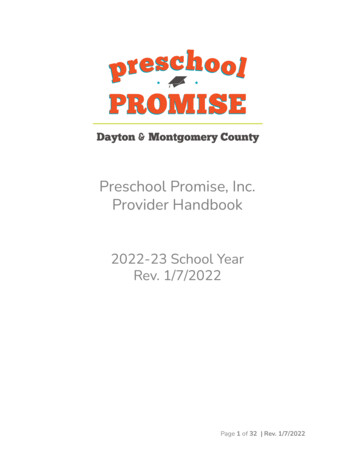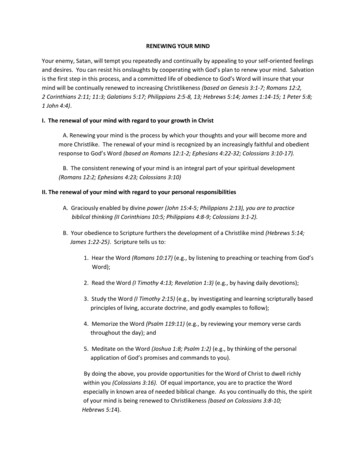
Transcription
FebruaryRenewing the Promise:State Policies to Improve HigherEducation PerformanceJoni E. Finney, Laura W. Perna, and Patrick M. CallanInstitute for Research on Higher EducationUniversity of Pennsylvania Graduate School of EducationHigher Education Policy Institute2014
Renewing the Promise:State Policies to Improve Higher Education PerformanceJoni E. Finney, Laura W. Perna, and Patrick M. CallanExecutive SummaryAs the need for a highly knowledgeable citizenry grows, fewer Americans areaccessing training and education beyond high school. The failure to attainpostsecondary degrees and workforce certificates is particularly pervasive amonglow-income and minority populations. An undereducated citizenry leaves the countryat a competitive disadvantage, diminishes the middle class, and lowers the standardof living for more and more people. Although the federal government plays animportant role in higher education, states bear the primary responsibility fordeveloping their own public higher education systems, including policies for fundingand governing higher education and for connecting higher education with publicschools.Renewing the Promise: State Policies to Improve Higher Education Performancesummarizes the findings from a study that sought to understand how public policyexplains the collective performance of higher education institutions in five states—Georgia, Illinois, Maryland, Texas, and Washington—that have similar challenges asother states, such as the need to increase educational attainment and close persistentgaps in opportunity by race, ethnicity, income, and geography. The study reviewedstate higher education performance and policies from the early 1990s throughapproximately 2010, including policies and statutes related to higher educationfinance, accountability, structure, and governance. We augmented our review of statepolicies and data by interviewing political, business, and higher education leaders ineach state.Findings and RecommendationsWe found that states struggle to develop policies in three general areas: using fiscalresources strategically; aligning educational opportunities to student needs; andeasing student transitions between educational sectors. Based on these findings, wemake the following policy recommendations:Make equity a top priority. The growing gaps in educational opportunity andattainment are one of the most serious issues facing higher education. No state1
ithoutcreatingalevelplayingfieldforlow- ‐income,minority,andfirst- o- ‐yeartofour- nthefuturewell- ationalattainment.2
cingtheeducatedcitizensneededtobuilda21st- manystudents—bothyoungpeopleandworking- ieldforlow- ‐income,minority,andfirst- ‐generationcollegestudents. CenteronEducationandtheWorkforceatG eorgetownU omeavailableasbabyboomersretire.1
Ourmulti- ,Illinois,Maryland,Texas,andWashington. - ‐to24- ‐year- ‐oldpopulations. 3TheAttainmentAgendaState Polic y Leadershipin Higher EducationLaura\\ '. Perna &Joni E. FinneyHwr:,;vnflir Patrick \ I. ationproviders:allpublictwo- ‐andfour- ‐yearinstitutions,privatenot- ‐for- ‐profitinstitutions,andprivatefor- ionsofHighSchoolGraduates(2012).2
epopulationaged25- ington(6%). ation.TheMeasuringUp ckedupagainstthebest- ate- eeGap:Percentof25- ucationalAttainmentbyDegree- 7MeasuringUpisabiennialstate- ‐by- ublicPolicyandHigherEducationfrom2000- ‐2008.3
hatextentareyoungandworking- ?Arestudentstransferringfromtwo- ‐yeartofour- aryeducation? nperformance hestate’sblack,Hispanic,andlow- ‐incomepopulations heprogram chnicalcollegesanddegree- llinois:StoryofDecline Top- harpdeclinesthrough2008 oandrestofIllinois,revealedalongracial/ethniclines ationknownas“systemofsystems” Politicalindifferencetowardhighereducation tooneofthenation’slargeststateneed- ‐basedfinancialaidprograms4
Maryland:MuchAccomplished,MuchatStake Top- ‐performingstateinmostareasofhighereducation ents 964CivilRightsAct rsandpoliticalleaders dtofamilyincomeTexas:HardChoicesAhead rformance,butevidenceofimprovement egoalsforeducationalopportunityandattainment ls opopulationvs.whitepopulation portunity tatefinancialaidprogram icyLeadershipVacuum Successinattractingwell- ‐educatedout- ‐of- degreeproduction mentstatewidestrategicplans sedinstitutionaltuition- ‐settingauthority tsevenwithstatepoliciesdesignedtoexpandupper- ‐divisioneducationopportunities5
ECIFIC CONTEXTA PublicAgenda forHigherEducationStrategicUse sessmentof ith StudentNeedsOverallAttainment& Equity estateswestudiedhavealong- stitutionalmission.6
BothIllinoisandWashingtonwereconsideredlow- ‐tomoderate- allyrecognized,need- asfollows:StateAppropriationsforHigherEducation nturnscreatedinstabilityinplanning. ion Inthreeofthefivestates,thedelegationoftuition- ghereducationfinanceissues. nancialAid Inadequateneed- ionincreased. Noneofthefivestatesprotectedneed- versitytoprovideupper- peratefour- ‐yearcollegesanduniversities.7
edcomprehensivefour- rtunitieswithstateneedsinclude: theother. ercostoffour- ‐yearprograms. dareas. tsecondaryeducationandbetweentwo- ‐yearandfour- e- ‐levelexpectationsbydevelopingend- ‐of- anenrolldirectlyincollege- ‐credit- assessmentsarereadytobeimplemented.8
Easingthetransferofstudentsfromtwo- ‐yeartofour- ovedbythefour- hrougheducationinclude: StatewideK- ‐16(orP- rarelyleadtostatepoliciestoimproveperformance. Statepoliciestoidentifyandassesscollege- ybetweenhighereducationandK- tainment. tedwithnolossofcredithoursbyfour- ninstitutions?Ourviewisthatalong- ‐termpolicyforapublicagendatiedtothewell- ereducationtowardthisend.9
RecommendationsforStatePolicymakers landcivicbenefit. dentsareofmodesteconomicmeans. oinvestinneed- ‐basedfinancialaid,thegapbetweenlow- ‐incomeandhigher- rovementineducationalattainment. asytransferforstudentsfromtwo- ‐yeartofour- ‐yearinstitutionswithoutlosingcredits.10
segoalsforeducationalattainment.Cost- challengeforallfivestates. atjustifythisimportantandambitiouspublicagenda.11
anddevelopedthenation’sfirststate- ‐by- ,Finneyhasco- dPresident- allanisco- lleges(2001),andco- onintheAg
state highereducation performanceand policies from the early 1990s through approximately2010, includingpolicies andstatutesrelatedto higher education finance, accountability,structure, and governance.We augmentedour review of state policies and databyinterviewingpolitical, business, and higher education leaders in each state.










